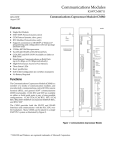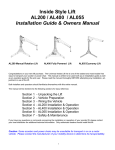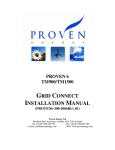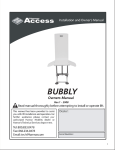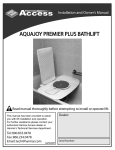Download Pioneer AL600 User's Manual
Transcript
AL600 Pioneer Hybrid Platform Lift (HPL) Installation Guide & Owner’s Manual Congratulations on your new lift purchase. The AL600 Pioneer is one of the easiest and most trouble free ways to transport your chair or scooter. This manual is written to be used both as an installation guide as well as an operation guide for the end user Refer to the index below for the sections that apply to your lift and options. Please read the manual thoroughly BEFORE attempting any installation, adjustment or use of the lift. Both installers and operators should familiarize themselves with this entire manual. If you have any questions or comments concerning the installation or operation of your scooter/chair lift, please contact your local distributor for additional technical information. Only authorized dealers should install this lift. Caution: Some scooters and chairs may be unsuitable for transport in or on a motor vehicle. Please contact the manufacturer of your mobility device to determine its transportability. Unpacking the Lift Detailed below is the inventory of parts included with your lift. If any parts are missing or if any shipping damage is noted, immediately contact the distributor from which you purchased your lift. DO NOT attempt to install or use the lift with any missing or damaged parts. Box Contents: 1 1 1 1 1 1 Lift Assembly Pioneer Platform Leg Assembly Hardware Pack Foot Plate Front Wheel Cradle (For Scooter Applications) Lift Assembly Pioneer Platform Front Wheel Cradle (for Scooter Applications) Pioneer Hardware Pack: Leg Assembly Foot Plate Owner’s Manual Vehicle Wiring Harness 2 Button Hand Control Manual Override Tool Hex Bolts DIA 5/16” x 4” Hex Nuts DIA 5/16” Washers 5/16” Lock Washers 5/16” Installation Washers Butt Connectors 10-12 gauge Rubber Grommet Tie Wraps 1 1 1 1 2 2 2 2 2 2 1 10 Applications: The Pioneer in its factory setup is intended for the transport of power chairs. With a minor change to the platform the Pioneer can easily be adapted for the transport of three or four wheel scooters. The maximum weight that can be safely lifted by the Pioneer in either setup is 350 LBS. This lift is intended for installation in the enclosed rear cargo area of most vans, mini-vans, and S.U.V.s. This lift is not intended for use with vehicles with tailgates. This lift is not intended for application where it would be left outdoors. Installing the Vehicle Wiring Harness Important Note: IMPROPER WIRING IS THE #1 CAUSE OF PROBLEMS IN THE OPERATION OF A VEHICLE LIFT. FOLLOW THE WIRING INSTRUCTIONS CAREFULLY Located in the hardware package is the vehicle wiring harness. The harness is manufactured to, and complies with the SAE J1128 requirements. The wire harness is approximately 23 ft. long and will accommodate most vehicles. Unwind the harness and lay it flat. One end of the harness has a black plug . This is the lift end of the harness and goes to the back of the vehicle. To back of vehicle To vehicle's battery E C LA IR KW B Begin routing the wiring harness at the vehicle battery. Attach the black wire to the negative terminal on the battery. Do not attach the red wire yet. E CK R WI A BL OR Top mount Side mount Run the wiring harness under or when possible through the vehicle, back to the trailer hitch. Always locate the wiring harness where it can not be snagged by road debris and away from the vehicles gas tank. If the harness is too long for the vehicle, coil the excess wire and secure it to the vehicle frame with the supplied tie wraps. Do not cut or shorten the harness. Secure the plug about even with the end of the hitch receiver tube. E RE D R WI Attach the red wire to the positive terminal on the battery. RED WIRE Important Reminder: Never attempt to attach the wire harness to a secondary power source, The lift requires direct connection to the battery. Side mount OR Top mount Caution: When the installation requires the wiring harness be run on the underside of a vehicle, route the harness away from the exhaust system, brake lines, fuel lines, gas tank, pinch points, and sharp edges. Locate the wiring harness where it can not be snagged by road debris. Manufactures Recommendation: Schedule a routine maintenance visit with the end user. Harmar recommends the lift be greased in the applicable areas, and the wire harness connections be checked for corrosion, and/or decay, as such conditions are normal due to environmental changes. Installing in Vehicles with a Removable Third Row Seat Preparing the vehicle’s cargo area: Most mini vans, vans and some S.U.V.s have a removable third row seat. Forinstallations in these vehicles, remove this seat. If your vehicle does not have a removable third row seat, see the next page for instructions. Installing the Leg Assembly: Place the leg assembly into the vehicle. Orientate the leg assembly as shown in the drawing to the right. Hook both of the J-Bolts into the third row seat attachment points. Verify that the leg assembly is centered from side to side within the vehicle. Tighten the nuts on the J-bolts until the assembly is firmly attached to the vehicle. At this time the foot plate should be placed in the vehicle near the rear opening. This will support the two rearmost feet of the lift and keep the feet from pressing into the floor pan of the vehicle. Install the 4 Leveling Pads from the hardware pack at this time. Each Pad will thread into the underside of the base at each corner. Leveling adjustment can be after the lift has been installed. S AIR H RC WE PO This part of the leg assembly must face toward the rear of the vehicle. J-Bolt Bracket: These parts must face toward the rear of the vehicle. Secure the JBolts into the 3rd row seat attachment points. R TE OO SC IR HA C ER W PO Leg Assembly This part of the J-Bolt must face toward the front of the vehicle Leg Assembly Placing the lift into the vehicle: Pick up the lift and place it into the vehicle’s cargo area. This operation will require two people to perform. Take care during this operation not to scratch the vehicle’s interior. Position the lift such that it will be one inch inside of the rear door. Verify this by closing the rear door and inspecting the fit from inside of the vehicle. If your vehicle has a lip at the rear door you will need to use the adjustable feet to raise the entire lift so that all of its moving parts will clear the door lip. R TE O CO Foot Plate Middle Stage Use a wrench to extend the adjustable feet until the lift’s middle stage will clear the door lip and door latch by 0.5”. Leveling the lift: The floor in some vehicles is not level. To level the lift start by parking the vehicle on level ground. Use a carpenter’s level to verify the lift is level. If it is not, adjust the four feet until the lift is level. Attaching the lift into the vehicle: The leg assembly has two sets of large holes in its upper surface. When installing a Pioneer for use with a scooter, select the holes that will offset the lift to the driver’s side of the vehicle. When installing the Pioneer for use with a power chair, select the holes that will offset the lift to the passenger's side of the vehicle. Insert both hold down rods into the holes in the Leg Assembly. If needed you may slide the hold down brackets along the lifts body so that the hold down rods line up with the holes in the top of the leg assembly. Crossbolt the hold down rods in place with the supplied hardware. Tighten the 5/8” nuts on the hold down rods, until the lift is attached securely to the vehicle. Caution: Do not remove the hold down brackets and reattach them on the opposite side of the Platform Keeper. Rear Door Lip Foot Plate Adjustable Feet Hold Down Brackets Hold Down Rod PLATFORM KEEPER Installing in Vehicles Without a Removable Third Row Seat Installing the Leg Assembly: Place the leg assembly into the vehicle. Orientate the leg assembly as shown in the drawing to the right. Also place the foot plate in the vehicle near the rear opening. This will support the two rearmost feet of the lift and keep the feet from pressing into the floor pan of the vehicle. Leg Assembly Install the 4 Leveling Pads from the hardware pack at this time. Each Pad will thread into the underside of the base at each corner. Leveling adjustment can be after the lift has been installed. Pick up the lift and place it into the vehicle’s cargo area. This operation will require two people to perform. Take care during this operation not to scratch the vehicle’s interior. Position the lift such that it will be one inch inside of the rear door. Verify this by closing the rear door and inspecting the fit from inside of the vehicle. Position the leg assembly so that it is located in line with the hold down rods on either side of the lift. (See the picture at the bottom of this page.) If needed you may slide the hold down brackets along the lift’s body. AIR R TE OO SC R WE CH PO IR R TE HA OO ER C C S W PO 5/16 x 4” Bolt 5/16” Washer 5/16” Nut This part of the leg assembly must face toward the rear of the vehicle. Foot Plate Installation Washer 5/16” Lock Washer Leg Assembly Remove the J-bolts from the leg assembly and replace them with the hardware shown in the drawing to the right. Use an 11/32” drill bit to drill holes though the vehicle floor for attaching the 5/16” bolts. Caution! Inspect the underside of the vehicle for obstacles before drilling any holes. Avoid the vehicle’s wiring, fuel lines, fuel tanks, spare tires, seat cushions, etc. From beneath the vehicle attach the installation washers, 5/16” lock washers and 5/16” nuts. Verify that the leg assembly is centered from side to side within the vehicle. Tighten the nuts on the 5/16” bolts until the assembly is firmly attached to the vehicle. If the vehicle has a lip at the rear door you will need to use the adjustable feet to raise the entire lift so that all ofits moving parts will clear the door lip. Middle Stage Use a wrench to extend the adjustable feet until the lift’s middle stage will clear the door lip and door latch by 0.5”. Leveling the lift: The floor in some vehicles is not level. To level the lift start by parking the vehicle on level ground. Use a carpenter’s level to verify the lift is level. If it is not, adjust the four feet until the lift is level. Attaching the lift into the vehicle: The leg assembly has two sets of large holes in its upper surface. When installing a Pioneer for use with a scooter, select the holes that will offset the lift to the driver’s side of the vehicle. When installing the Pioneer for use with a power chair, select the holes that will offset the lift to the passenger's side of the vehicle. Insert both hold down rods into the holes in the Leg Assembly. Crossbolt the hold down rods in place with the supplied hardware. Tighten the 5/8” nuts on the hold down rods, until the lift is attached securely to the vehicle. Caution: Do not remove the hold down brackets and reattach them on the opposite side of the Platform Keeper. Rear Door Lip Foot Plate Adjustable Feet Hold Down Brackets Hold Down Rod PLATFORM KEEPER Installing the Pioneer Connecting the Electrical Components: Plug the hand control into the vehicle wiring harness. Then plug the other end into the electrical harness located on the rear of the lift. Extending the Lift: Push the down button on the hand control to extend the lift in the horizontal direction. CAUTION: Watch the lift as it extends. Make sure the moving components of the lift do not rub against the vehicle’s interior, door lip, or door latch. You may need to stop and adjust the lifts height, by repeating the steps on the installation page. When the lift is fully extended, it will start to run down in the vertical direction. At this point stop the lift. If you are using the Pioneer to lift power chairs the platform is now ready to be installed. If you are using the Pioneer to transport scooters, follow the instructions on the Page 8 for how to modify the platform for use with a Scooter. Installing the Platform for use with a Power Chair: Bolt the platform to the lift assembly as shown to the right using the supplied 1/2” diameter and 5/16” diameter hex bolts. Hand Control Vehicle Wiring Harness Lift Preparing the Power Chair or Scooter for the Pioneer There are 2 options on how to attach the strap hooks to the chair that are included with the lift. Anchor Plate: The Anchor Plate is a flat plate that is 20” long with 2 slots in each end. This plate will work with any chair or scooter that has a center seat post that attaches to the bottom of the seat. Attach the Anchor Plate by the following steps. 1. Remove the seat from the chair and turn it over. 2. Loosen the screws that attach the plate to the bottom of the seat. Allow enough room to slide the Anchor Plate between the seat and the seat plate. 3. Attach the Anchor Plate in the center of the seat plate with the holes on each end extending evenly on each side of the seat. 4. Retighten the screws that hold the seat plate to the bottom of the seat. 5. Replace the seat on the chair. The Anchor Plate should extend about 1-1/2” out from the side of the seat cushion. This will allow the user to attach the strap hooks to the Anchor Plate to secure the chair to the lift. Anchor U-Bolts: The U-Bolts are to be used with Power Chairs or Scooters that do not have a center seat post. On this type of chair, the seat is normally attached to a tubular frame. Attach the U-Bolts, two on each side, to the frame as shown below. Make sure that the loop extends to the outside of the chair to allow the strap hooks to be attached by the end user. Each type of chair will differ slightly and the placement of the U-bolts will differ between different models and manufacturers. Place the Anchor U-Bolts towards the center of the seat if possible. Because of the different types of seats, you may be forced to attach the Anchor U-Bolts more towards the front or rear of the seat, but we recommend attachment as close as possible to the center of the seat. Loading a Power Chair Parking the Chair on the Platform: Before loading the power chair, verify that the platform has been lowered all the way to the ground. Set your chair’s speed control at a slow speed so that you may maneuver comfortably onto the platform. You may drive onto the platform from either side. Park the chair such that it is centered on the platform. Securing the Chair to the Platform: The Pioneer platform has a restraint attached to each corner of the platform. Each restraint has a hook at the end. Place each hook in either the anchor plate slot, or in each U-bolt. Pull the loose end of each restraint tight. To release, simply press the release tab, and remove the hooks. Folding Seat Backs: If your chair has a folding seat back you may wish to fold it to the down position. This will allow you more clearance when loading the chair into the vehicle. Depending on the size of your chair, you may need to remove the head rest to provide for sufficient clearance. Raising the Chair: Before raising, verify that the chair is secured to the platform. While holding the hand control stand to the side and away from the lift. Press the up button. The lift will raise and retract into the vehicle. The lift is retracted fully when the platform is fully inside of the vehicle and the lift’s motion stops. At this point release the button. Secure the hand control by placing it on the hook and loop patch attached to the lift. Close the rear door carefully taking notice of any baskets, backpacks or additional items attached to the chair that may be hit by the door. PUSH to RELEASE PULL to TIGHTEN Platform Preparation for Use with Scooters Modifying the Platform for use with Scooters: Contained in the lift box will be the front wheel scooter adapter. This must be attached to the platform for all scooter applications. Attach the front wheel scooter adapter using the provided hardware to the platform end plates on the passenger's side of the platform. ( Remove the two restraints, add the front wheel craddle, and reassemble the restraints in the same holes from which they were removed ) Installing the Platform for use with a Power Chair: Bolt the platform to the lift assembly as shown to the right using the supplied 1/2” diameter and 5/16” diameter hex bolts. Loading a Scooter Parking the Scooter on the Platform: Before loading the scooter, verify that the platform has been lowered all the way to the ground. Set your scooter’s speed control at a slow speed so that you may maneuver comfortably onto the platform. You must driv e onto the platform from the driver’s side of the vehicle. Park the scooter such that the front wheel(s) is(are) on top of the front wheel scooter adapter. Securing the Scooter to the Platform: The Pioneer platform has a restraint attached to each corner of the platform. Each restraint has a hook at the end. Place each hook in either the anchor plate slot, or in each U-bolt. Pull the loose end of each restraint tight. To release, simply press the release tab, and remove the hooks. Folding Seat Backs: If your scooter has a folding seat back you may wish to fold it to the down position. This will allow you more clearance when loading the scooter into the vehicle. Depending on the size of your scooter, you may need to remove the head rest to provide sufficient clearance. Stowing the Scooter: While holding the hand control, stand to the side and away from the lift. Press the up button again. The lift will raise and retract into the vehicle. The lift is retracted fully when the platform is inside of the vehicle and the lift’s motion stops. At this point release the button. Secure the hand control by placing it on the hook and loop patch attached to the lift. Close the rear door carefully taking notice of any baskets, backpacks or additional items attached to the scooter that may be hit by the door. PUSH to RELEASE PULL to TIGHTEN SAFETY: · · · · · · Caution: Do not operate this lift until your dealer has satisfactorily instructed you in the proper operation of the lift. Your Harmar lift has been engineered and designed for years of trouble free use. Although, with everyday use, some parts may become loose or worn. IMPORTANT! Check regularly for any worn, loose or damaged parts of your lift. If anything is observed, DO NOT USE THE LIFT! Contact your dealer or installer of the lift for repairs to be made. Failure to act may cause severe injury! Your Harmar lift should only be used for the loading and unloading of scooters and power wheelchairs for which it is designed. DO NOT add to or modify any part of the lift system without first contacting the manufacturer of the lift. Any modifications may void any warranties as well as effect the structural integrity of the lift. Always make sure the vehicle’s parking brake is firmly set before operating the lift. Caution: When using the lift, keep your hands and feet from under the scooter or power chair as it is being loaded or unloaded. Warning: This lift is not meant for human transport. The mobility device and platform must be unoccupied before operating the lift. MAINTENANCE: The Harmar lift has been designed to be as trouble free as possible for the owner. But, as with any mechanical device, regular care should be given while owning and using this device. Maintenance should be performed regularly. · · We recommend that dealers schedule a preventative maintenance inspection at least once a year on motors, lift frame, wiring harness and all moving parts of the lift. Check for paint chips and touch up any bare metal with a good gloss black enamel or lacquer to inhibit rust. This may be necessary more frequently when subjected to salt air or road salt. TROUBLESHOOTING: PROBLEM: The lift will not operate or operates slowly. Possible Causes: Bad Connection - Verify the vehicle wiring harness is tightly attached to the battery and that there is no build up on the terminals. Battery - Check to see if the battery needs to be replaced or if the terminals are corroded. Clean the terminals if any corrosion is present. 12 volts should be present at the lifting motors from the vehicles battery. This can be tested with a voltage meter. PROBLEM: Intermittent power to the lift. The lift will operate for a short period of time and quit. At a later time it will start working again. Possible Causes: Circuit Breaker - Although the breaker resets itself automatically, it may be malfunctioning and need to be replaced. Check for power at the lift with a test lamp. Bad Connection - Verify the vehicle wiring harness is tightly attached to the battery and that there is no build upon the terminals. Hand Control - Test by bypassing the hand control. Do this for only a second or two. The lift, vehicle, scooter or chair may be damaged if continuous power is left supplied to the unit. PROBLEM: Platform will not sit level on the ground. Possible Causes: Terrain - Verify that the vehicle is parked on flat level ground. Orientation of the lift’s base - Adjust the lift’s four feet until the platform sits level on the ground.












